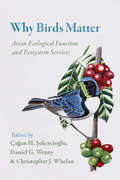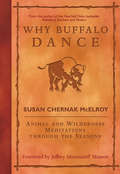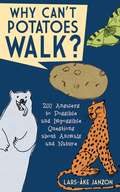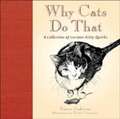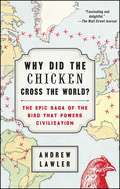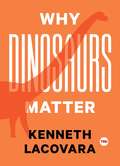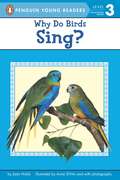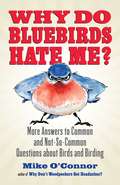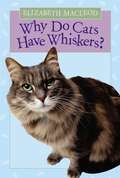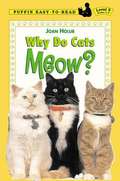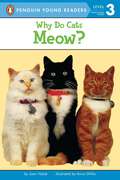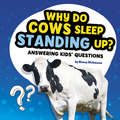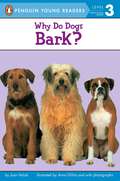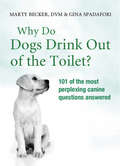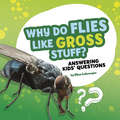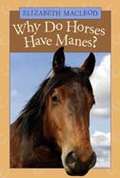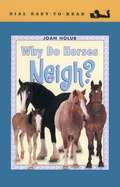- Table View
- List View
Why Biodiversity Matters (Changing Planet)
by Nigel DudleyAll life on Earth has the right to exist, but as we teeter on the verge of a sixth extinction this book discusses why biodiversity matters and why we should care if species go extinct. We are witnessing the largest and fastest rate of extinction in the history of the planet. While the concept of rights is a human one, all plants and animals strive to survive, and this book argues for their rights to continue doing so without being driven into premature extinction by human actions. Acknowledging and describing the practical reasons for conserving biodiversity, this book argues that these should not overshadow the compelling ethical reasons to care about the future of species other than our own. However, the issues are complex. What do we do when faced with an immediate ethical choice where biodiversity rights, animal rights, human rights, economic development and ecosystem survival all get mixed up together? There are seldom hard and fast answers, but thinking about and understanding a variety of points of view will help us make informed trade-offs. Drawing on his vast practical experience, the author presents insightful perspectives and real-world examples with the hope that this book will instigate a much-needed rethink about why and how we practise conservation. This book is essential reading for all those concerned with sustaining our planet, and all who inhabit it, in the face of climate breakdown, biodiversity loss and ecological collapse.
Why Birds Matter: Avian Ecological Function and Ecosystem Services
by Christopher J. Whelan Daniel G. Wenny Çağan H. Şekercioğlu, Daniel G. Wenny, and Christopher J. WhelanFor over one hundred years, ornithologists and amateur birders have jointly campaigned for the conservation of bird species, documenting not only birds’ beauty and extraordinary diversity, but also their importance to ecosystems worldwide. But while these avian enthusiasts have noted that birds eat fruit, carrion, and pests; spread seed and fertilizer; and pollinate plants, among other services, they have rarely asked what birds are worth in economic terms. In Why Birds Matter, an international collection of ornithologists, botanists, ecologists, conservation biologists, and environmental economists seeks to quantify avian ecosystem services—the myriad benefits that birds provide to humans. The first book to approach ecosystem services from an ornithological perspective, Why Birds Matter asks what economic value we can ascribe to those services, if any, and how this value should inform conservation. Chapters explore the role of birds in such important ecological dynamics as scavenging, nutrient cycling, food chains, and plant-animal interactions—all seen through the lens of human well-being—to show that quantifying avian ecosystem services is crucial when formulating contemporary conservation strategies. Both elucidating challenges and providing examples of specific ecosystem valuations and guidance for calculation, the contributors propose that in order to advance avian conservation, we need to appeal not only to hearts and minds, but also to wallets.
Why Buffalo Dance
by Susan Chernak McelroyIn this elegantly written and illustrated book, bestselling author Susan Chernak McElroy has gathered the voices of the wind, weather, animals, and elements and transcribed the he truths they have to share. Badgers and bison, magpies and moose, eagles and elk, all have wisdom teachings that shed light on our common journey through life.
Why Can't Potatoes Walk?: 200 Answers to Possible and Impossible Questions about Animals and Nature
by Lars-Åke Janzon Lukas MöllerstenWhen it comes to animals and nature, there is no end to our curiosity. Around ten thousand questions a year land on Lars-Åke Janzon's desk at the Swedish Museum of Natural History. In this sequel to the successful book How Long Can a Fly Fly?, Janzon responds to nutty questions, freak happenings, and odd observations with interesting facts and explanations. Learn about snake sex, animals' brightly colored warning signals, and why a vulture was arrested in Saudi Arabia on suspicion of being an Israeli spy. Find out the facts behind the headlines about Thailand's poisonous jellyfish and the "killer sharks" of Sharm el-Sheikh. For over ten years, Janzon has been researching the answers to questions like: What color will a chameleon turn if it lies on a chessboard? Why are flounders flat? How do sea urchins make love? How did wolves become big and bad? Why do animals migrate across Africa? Which animal has the longest tongue? Do fish spit?In addition to answering these and many other questions, Janzon breaks down scientific terminology, lists animal stats, debunks myths, and answers all sorts of did-you-knows you never even thought to ask about nature and evolution.Written with warm humor and educational zeal and accompanied by Lukas Möllersten's imaginative illustrations, this fun and educational book is perfect for all ages of readers with a casual interest in understanding just a little bit more about nature.
Why Cats Do That
by Karen AndersonWHY DO CATS PURR? WHY DO CATS GET stuck in trees? Why do they bring us their latest catch? Why do cats always land on their feet? Learn the fascinating and sometimes surprising facts about these and 36 other curious cat behaviors - light-heartedly explained and beautifully illustrated in this book. Author Karen Anderson and illustrator Wendy Christensen are both sincere cat-lovers whose admiration and devotion to their feline companions are sure to strike a chord with everyone who has a cat (or many cats!) in their midst. Illustrations are described by the scanner.
Why Coyote Howls at the Moon (Rigby Leveled Library, Level L #38)
by Rob Arego Vicki BradleyNIMAC-sourced textbook
Why Did the Chicken Cross the World?
by Andrew LawlerFrom ancient empires to modern economics, veteran journalist Andrew Lawler delivers a sweeping history of the animal that has been most crucial to the spread of civilization across the globe--the chicken.Queen Victoria was obsessed with it. Socrates' last words were about it. Charles Darwin and Louis Pasteur made their scientific breakthroughs using it. Catholic popes, African shamans, Chinese philosophers, and Muslim mystics praised it. Throughout the history of civilization, humans have embraced it in every form imaginable--as a messenger of the gods, powerful sex symbol, gambling aid, emblem of resurrection, all-purpose medicine, handy research tool, inspiration for bravery, epitome of evil, and, of course, as the star of the world's most famous joke. In Why Did the Chicken Cross the World?, science writer Andrew Lawler takes us on an adventure from prehistory to the modern era with a fascinating account of the partnership between human and chicken (the most successful of all cross-species relationships). Beginning with the recent discovery in Montana that the chicken's unlikely ancestor is T. rex, this book builds on Lawler's popular Smithsonian cover article, "How the Chicken Conquered the World" to track the chicken from its original domestication in the jungles of Southeast Asia some 10,000 years ago to postwar America, where it became the most engineered of animals, to the uncertain future of what is now humanity's single most important source of protein. In a masterful combination of historical sleuthing and journalistic exploration on four continents, Lawler reframes the way we feel and think about our most important animal partner--and, by extension, all domesticated animals, and even nature itself. Lawler's narrative reveals the secrets behind the chicken's transformation from a shy jungle bird into an animal of astonishing versatility, capable of serving our species' changing needs. For no other siren has called humans to rise, shine, and prosper quite like the rooster's cry: "cock-a-doodle-doo!"
Why Dinosaurs Matter (TED Books)
by Kenneth LacovaraWhat can long-dead dinosaurs teach us about our future? Plenty, according to paleontologist Kenneth Lacovara, who has discovered some of the largest creatures to ever walk the Earth.By tapping into the ubiquitous wonder that dinosaurs inspire, Lacovara weaves together the stories of our geological awakening, of humanity&’s epic struggle to understand the nature of deep time, the meaning of fossils, and our own place on the vast and bountiful tree of life. Go on a journey––back to when dinosaurs ruled the Earth––to discover how dinosaurs achieved feats unparalleled by any other group of animals. Learn the secrets of how paleontologists find fossils, and explore quirky, but profound questions, such as: Is a penguin a dinosaur? And, how are the tiny arms of T. rex the key to its power and ferocity? In this revealing book, Lacovara offers the latest ideas about the shocking and calamitous death of the dinosaurs and ties their vulnerabilities to our own. Why Dinosaurs Matter is compelling and engaging—a great reminder that our place on this planet is both precarious and potentially fleeting. &“As we move into an uncertain environmental future, it has never been more important to understand the past.&”
Why Do Birds Sing?
by Joan HolubDid you know: there are over nine thousand kinds of birds; a bee hummingbird weighs as little as a dime; a peregrine falcon can spot a mouse a mile away; swifts can sleep while flying! Many of us love birds and also enjoy them as pets. This fact- and photo-packed book takes a look at their behavior and characteristics and offers ways to get to know and appreciate them. For instance, you'll discover how birds fly, which are the best swimmers, which ones make good pets, and, of course, what all that singing is about! Joan Holub has created stories and art for over seventy children's books, including the ABA Pick of the Lists titles Why Do Dogs Bark? and Why Do Cats Meow? While her dad kept peacocks, pheasants, and chickens as pets, Joan prefers the company of the wild birds that congregate outside her kitchen window, eager for their daily feeding. Joan and her husband, George, live in Seattle, Washington, and do their best to keep their two cats away from their feathery friends.
Why Do Birds Sing? (Penguin Young Readers, Level 3)
by Joan HolubDo you love birds? If you do, you're not alone! Birds are fun to watch and they make great pets. There is so much to know about birds. Why do they have feathers? Can parrots really talk? Why do birds build nests? Do birds like toys? Beginning readers will find the answers to these questions—and many more—in this lively, fact-filled book. Filled with colorful illustrations and photographs of wild and domestic birds, this is a perfect selection for any young bird-watcher or bird lover.
Why Do Bluebirds Hate Me?: More Answers to Common and Not-So-Common Questions about Birds and Birding
by Mike O'ConnorA collection of humorous Q&As about everything you've always wanted to ask about birds and birding Mike O'Connor knows bird watchers as well as he knows birds. He knows that if you're even slightly interested in identifying birds or attracting them to your backyard with a feeder, then you've also had your share of strange and silly questions about birds and their sometimes inexplicable behavior. In Why Do Bluebirds Hate Me?, O'Connor applies his deep knowledge of all things avian to answer the questions that keep birders up at night. Questions like · Should you clean your birdhouses? · Do swallows have a feather fetish? · How much does it cost to run a heated birdbath? · Is drinking coffee bad for birds? Other questions O'Connor covers range from the practical (Should I rotate the seed in my feeder?) to the quirky (Why are vultures eating my vinyl screen door?) to the just plain adorable (Are those birds kissing or feeding each other?). And he also explains why bluebirds just don't seem to like some people.From the Trade Paperback edition.
Why Do Cats Do That?: Real Answers to the Curious Things Cats Do
by Kim Campbell ThorntonWhy Do Cats Do That? discusses twenty peculiar feline habits that have puzzled cat owners since the first semi-domesticated cat plopped a dead baby dodo on a caveman's doorstep! Why do cats bring us mangled mice as gifts? How and why does a cat purr? Why do cats land on their feet? (Do they always land on their feet?)<P><P> These questions and others are explored and sometimes resolved in an entertaining and instructive format. More than good fun, owners will discover the reasons behind common behavioral problems, including litter box accidents, furniture scratching, spraying, and more. Feline facts and training ideas plus lots of funny cat photos complete this Simple Solutions book.
Why Do Cats Have Whiskers?
by Elizabeth MacleodDid you know that cats can smell over 200 million different scents? Or that you can communicate with your cat just by blinking?
Why Do Cats Meow? (Easy-to-Read)
by Joan HolubDo you love cats? If you do, you're not alone! Cats are the most popular pet in the United States. There is so much to know about cats. Why do they meow, hiss and purr? Why do they have whiskers, tails and claws? Can they really see in the dark? You'll find out the answers to these questions and many more in this fun, fact-filled book.
Why Do Cats Meow? (Penguin Young Readers, Level 3)
by Joan HolubMany children love cats, and there is so much to know about America's most popular pet. Why do they meow, hiss, and purr? Why do they have whiskers, tails, and claws? Beginning readers can find out the answers to those questions and many more in this fun, fact-packed book filled with colorful feline photos and drawings.
Why Do Cows Sleep Standing Up?: Answering Kids' Questions (Questions and Answers About Animals)
by Nancy DickmannPeople don’t sleep standing up. But cows do! Why? You have questions, and this book has the answers. Find out all about cows and why they don’t need to lie down to catch some Zzzzzs.
Why Do Dogs Bark?
by Joan HolubDid you know that there's a dog so little, it can fit in your hand? That dogs and wolves are relatives? A dog once kept a snowbound town from getting sick? That dogs, unfortunately, cannot brush their teeth? Dogs are our friends, protectors, and family members. This fact-packed book takes a look at their history, behavior, and characteristics, and offers ways to get to know them a little better. For instance, what does it mean if a dog's tail is up, or its ears are back? How can you get a dog to sit or stay? And, of course, just what is the reason for all that barking?
Why Do Dogs Bark? (Penguin Young Readers, Level 3)
by Joan HolubThere are many different kinds of dogs and so much to find out about them. Why do dogs bark, howl, or bury bones? Why do they like to lick and sniff people? What jobs can dogs do? You'll find the answers to these questions and many more in this fact-filled reader about man's best friend.
Why Do Dogs Do That?: Real Answers to the Curious Things Canines Do?
by Kim Campbell ThorntonPresented in a format that any dog lover will enjoy, this fun-fact book discusses twenty curious topics that have plagued the minds of dog owners for generations. From the simple, straightforward queries, "Why do dogs bark?" and "Why do dogs chew?" to the more challenging musings, "Why do dogs eat grass" and "Why do dogs howl?" More than just entertainment, owners will discover the reasons behind common training problems, including car and cat chasing, jumping up, pulling on the leash, digging, and more. For those polite dog owners afraid to ask, there are answers for you, too, to questions like "Why do dogs eat poop?" and "Why do dogs sniff butts?" Fun tidbits for everyone, plus hilarious illustrations by Keith Robinson, in this Simple Solutions book.
Why Do Dogs Drink Out Of The Toilet?
by Marty Becker Gina SpadaforiA light-hearted look at everything you ever wanted to know about dogs ... but were afraid to ask!To the untrained eye not much that dogs do makes sense. What possible reason can there be for barking when you're on the phone, smelling each other's behinds and rolling in stuff that stinks? Award winning pet experts Dr Marty Becker and Gina Spadafori take you on a trip into the canine mind. You'll also discover:* How hunting dogs suppress their basic instinct* Whether Border Collies are the cleverest dogs?* If good dogs go bad in packs?* Why dogs get stuck together after mating?* Whether dogs learn better with praise or punishment?* Why some dogs pump their leg when you tickle their tummies?* Is it possible for puppies from the same litter to have different fathers?* Why dogs cock their heads when they hear unusual sounds?And a few others you've never dared ask!
Why Do Dogs Like Balls?: More Than 200 Canine Quirks, Curiosities, and Conundrums Revealed
by D. Caroline Coile Margaret H. BonhamDo dogs believe pictures of dogs are real? Why do dogs turn in a circle before they lie down? Can you trust someone your dog hates? Dog owners have questions; here are the answers to more than 200 of them, provided by two of the most knowledgeable writers in the field. Fun to read, eye-opening, and filled with important facts that every fan of Fido should know, it encompasses topics ranging from doggie intelligence (Can dogs learn to read?) to canine behavior, body, and senses (Can a dog sniff out cancer?). Find out if blind dogs are sad, whether dogs should be allowed to roam, why they lick you, and why they wag their tails. You'll gain a better, deeper understanding of your best friend.
Why Do Elephants Need the Sun?
by Robert E WellsThere are trillions of stars in the universe, but we rely on our sun to provide (or contribute to) most of what we need to survive and thrive: heat, light, plants, animals, wind, and water. Complete with fun, cartoon illustrations, Robert Wells's new book gives kids plenty of information about our sun in an easy-to-read-and-digest format. By focusing on the needs of an elephant, Wells makes clear just how important the sun is to life on Earth.
Why Do Flies Like Gross Stuff?: Answering Kids' Questions (Questions and Answers About Animals)
by Ellen LabrecqueSmelly trash, rotting food, and piles of poop are disgusting! But not to flies! Why? You have questions, and this book has the answers. Find out all about flies, including their body parts, young, food, and behavior.
Why Do Horses Have Manes?
by Elizabeth MacleodLike Why Do Dogs Have Wet Noses and Why Do Cats Have Whiskers?, the question-and-answer format makes this book perfect both for browsing and for school-project research.
Why Do Horses Neigh?
by Joan HolubDo you Love Horses? If you do, you're not alone! There's so much to know about horses. Why do horses neigh? What are baby and adult horses called? What is tack? How can you learn to ride a horse? Find out all the answers-and much more-in this lively fact-filled introduction to horses. Reading Level: 2.4

